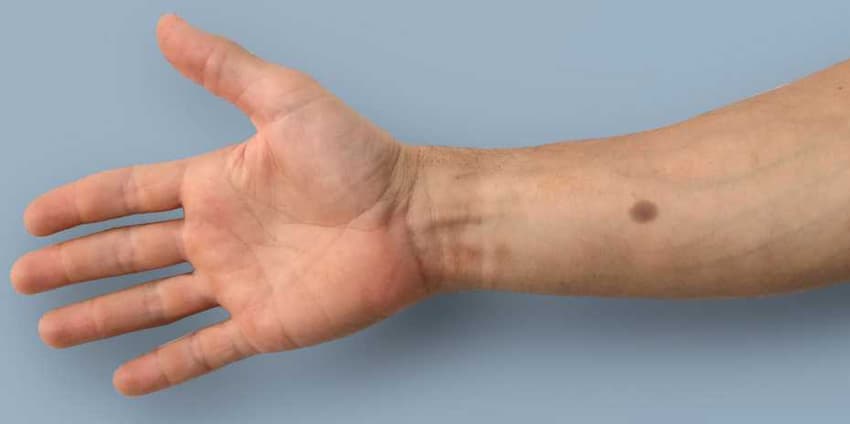'Biomedical tattoo' could provide early cancer warning: Swiss study

Swiss scientists have developed an experimental skin implant that darkens like a mole when it detects subtle changes in the body that may be an early warning sign of cancer, a study said on Wednesday.
The implant, or "biomedical tattoo," as researchers call it, has been tested in lab animals, lasts about a year and recognises the four most common types of cancer: prostate, lung, colon and breast cancer.
Read also: Swiss researchers try to get ancient Roman fridge working (again)
It works by reacting to the level of calcium in the blood, which rises when a tumuor is developing. About 40 percent of cancers could theoretically be detected this way, researchers said.
Synthetisches Gennetzwerk als Frühwarnsystem. Bahnt sich ein Tumor an, bildet sich in der Haut ein sichtbarer Leberfleck. Das "biomedizinische Tattoo" wurde von ETH-Forschern um Martin Fussenegger entwickelt. #Krebsforschunghttps://t.co/TV2Shgli1a pic.twitter.com/TqnHqzcQjY
— ETH Zürich (@ETH) April 18, 2018
"The biomedical tattoo detects all hypercalcemic cancers at a very early, asymptomatic stage," lead author Martin Fussenegger, Professor at the Department of Biosystems Science and Engineering at ETH Zurich, told AFP by email.
"If blood calcium levels remain high over longer periods of time, the calcium sensor in the biomedical tattoo cells produces an enzyme, tyrosinase, which converts the amino acid into the black skin pigment, melanin."
If the wearer notices the spot darken, they should see a doctor to clarify the reason for the change and determine if or what treatment is warranted, he said.
"Early detection increases the chance of survival significantly," he said.
"Nowadays, people generally go to the doctor only when the tumor begins to cause problems. Unfortunately, by that point it is often too late."
The implant was tested in mice with either cancerous tumors that cause hypercalcemia or tumors that do not affect calcium blood levels.
During a 38-day experiment, the tattoos appeared only on the skin of the hypercalcemic mice, which showed no symptoms of illness.
More research and funding is needed to advance the tattoo to clinical trials in people, and the process could take a decade, Fussenegger said.
A paper describing the prototype was published in the journal Science Translational Medicine.
Comments
See Also
The implant, or "biomedical tattoo," as researchers call it, has been tested in lab animals, lasts about a year and recognises the four most common types of cancer: prostate, lung, colon and breast cancer.
Read also: Swiss researchers try to get ancient Roman fridge working (again)
It works by reacting to the level of calcium in the blood, which rises when a tumuor is developing. About 40 percent of cancers could theoretically be detected this way, researchers said.
Synthetisches Gennetzwerk als Frühwarnsystem. Bahnt sich ein Tumor an, bildet sich in der Haut ein sichtbarer Leberfleck. Das "biomedizinische Tattoo" wurde von ETH-Forschern um Martin Fussenegger entwickelt. #Krebsforschunghttps://t.co/TV2Shgli1a pic.twitter.com/TqnHqzcQjY
— ETH Zürich (@ETH) April 18, 2018
"The biomedical tattoo detects all hypercalcemic cancers at a very early, asymptomatic stage," lead author Martin Fussenegger, Professor at the Department of Biosystems Science and Engineering at ETH Zurich, told AFP by email.
"If blood calcium levels remain high over longer periods of time, the calcium sensor in the biomedical tattoo cells produces an enzyme, tyrosinase, which converts the amino acid into the black skin pigment, melanin."
If the wearer notices the spot darken, they should see a doctor to clarify the reason for the change and determine if or what treatment is warranted, he said.
"Early detection increases the chance of survival significantly," he said.
"Nowadays, people generally go to the doctor only when the tumor begins to cause problems. Unfortunately, by that point it is often too late."
The implant was tested in mice with either cancerous tumors that cause hypercalcemia or tumors that do not affect calcium blood levels.
During a 38-day experiment, the tattoos appeared only on the skin of the hypercalcemic mice, which showed no symptoms of illness.
More research and funding is needed to advance the tattoo to clinical trials in people, and the process could take a decade, Fussenegger said.
A paper describing the prototype was published in the journal Science Translational Medicine.
Join the conversation in our comments section below. Share your own views and experience and if you have a question or suggestion for our journalists then email us at [email protected].
Please keep comments civil, constructive and on topic – and make sure to read our terms of use before getting involved.
Please log in here to leave a comment.